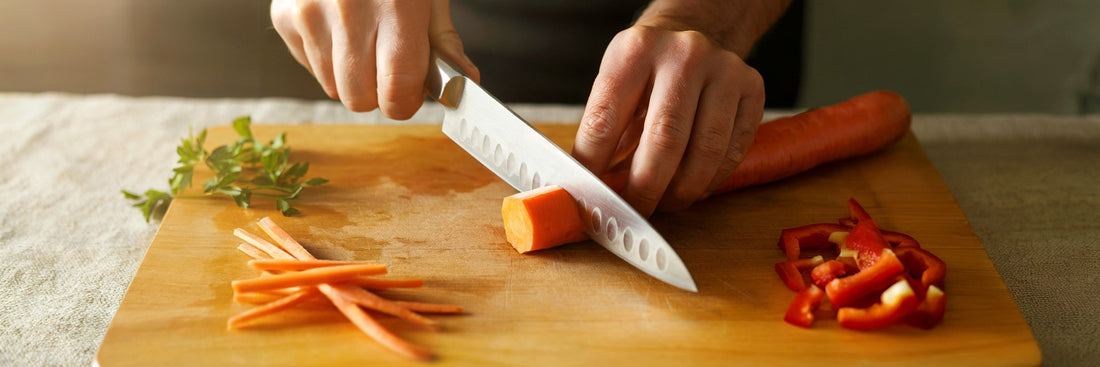
Knife Skills 101: Proper Cutting Techniques for Various Vegetables
Mastering vegetable cutting techniques transforms your cooking from simple meal preparation into an artful practice. Sharp knife skills enhance presentation, ensure even cooking, and improve both texture and flavor in your meals. With the right tools and techniques, your kitchen becomes a place where precision meets creativity.
Essential Tools for Success
The Foundation: Quality Cutting Boards A premium hardwood cutting board—like North American maple or walnut—provides the stable, knife-friendly surface for safe, precise cutting. Unlike synthetic alternatives, hardwood boards develop character over time while maintaining their structural integrity and gentle treatment of your knife edges.
Sharp Tools for Sharp Skills
- A well-maintained chef's knife (8-inch is most versatile)
- A paring knife for detailed work
- A honing steel to maintain your edge between sharpenings
Remember: a sharp knife requires less pressure and gives you complete control, making it significantly safer than struggling with a dull blade.
Basic Cutting Techniques
1. Slicing
Slicing is the foundation of all knife work. Master this technique first:
- Hold the knife with your dominant hand, gripping the handle and placing your thumb and index finger on either side of the blade.
- Use your other hand to hold the vegetable, curling your fingertips under to protect them.
- Draw the knife through the vegetable in a smooth, forward motion.
2. Dicing
Uniform cubes ensure even cooking and professional presentation:
- First, slice the vegetable into planks.
- Stack the planks and cut them into strips.
- Turn the strips 90 degrees and cut across them to create cubes.
3. Julienne
These elegant matchstick pieces elevate any dish:
- Slice off one side of the vegetable to create a flat surface.
- Cut the vegetable into thin slices.
- Stack the slices and cut them into thin strips.
4. Chiffonade for Herbs
Perfect for delicate leafy herbs and greens:
- Stack the leaves on top of each other.
- Roll them tightly into a cigar-like shape.
- Slice across the roll to create thin ribbons.
Vegetable-Specific Techniques
Onions
The foundation of countless dishes deserves proper technique:
- Halve the onion from root to tip, leaving the root end intact
- Remove papery skin while preserving the root connection
- Make horizontal cuts toward (but not through) the root
- Create vertical cuts perpendicular to your first cuts
- Slice across both cut patterns for perfectly diced pieces
Bell Peppers
Transform these colorful vegetables efficiently:Transform these colorful vegetables efficiently:
- Remove top and bottom to create stable surfaces
- Stand upright and slice down each side, avoiding seeds and core
- Lay pieces flat, skin-side down, for easy slicing or dicing
Carrots
Versatile techniques for this kitchen staple:
- For rounds: slice straight across at your desired thickness
- For julienne: create flat planks, then slice into matchstick strips
- Angle your cuts for elegant diagonal pieces
Tomatoes
Preserve the integrity of this tender fruit:
- Use a razor-sharp knife to avoid crushing (a serrated knife works if your blade needs attention)
- For clean slices: cut straight across with gentle pressure
- For dicing: halve the tomato, then slice and dice each half separately
Building Your Skills
These techniques improve with mindful practice. Quality tools make this practice more enjoyable and effective. Start slowly, focusing on consistent, safe movements. Your cutting board becomes both workspace and teacher—the rhythmic sound of proper knife work and the feel of clean cuts through vegetables signal developing mastery.
Your cutting board serves as the foundation for all these techniques. Choose quality hardwood that will improve with use, supporting your growing skills for years to come.
